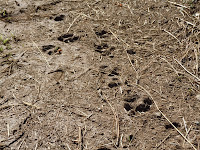 |
| The Cantina at Rancho de la Osa, built c. early 1700s |
I had the privilege of visiting
Rancho de la Osa Guest Ranch in Sasabe, AZ, just southwest of Tucson. This 300+ year old property is located on the border of Mexico (to the South), the
Tohono O'odham Nation land (to the West), Mirador Ranch (to the North) and the
Buenos Aires National Wildlife Refuge (to the East).
 |
| Mission Bell from Fr. Kino's time |
This Sonoran desert ranchland was originally settled as a mission outpost by Jesuit Missionary, Father Eusebio Kino on behalf of Spain. The Cantina on the Rancho de la Osa property is purportedly the oldest building in Arizona, with use since the early 1700s. The old mission bell is used today to call ranch guests to meals.
The ranch buildings are made from original adobe and the walls are at least two feet thick, keeping the buildings cool in the summer and warm in the winter. The current owners, Richard and Veronica Schultz run the ranch themselves, along with wranglers who pull double duty as bartenders, a housekeeper/meal-server, receptionist and interns. Occasionally, there is the fortune of a handyman as well. The Schultz' and their staff (who live on the property) fulfill multiple duties to ensure guests have a magnificent time. Veronica is a star chef and one of her signature dishes, piñon-crusted chicken with cherry chipotle sauce was selected as the official entree for the Arizona Centennial menu. I can guarantee you that you will not leave hungry with three meals a day and that the food will satisfy since the menu is built off of guest preferences and customized to avoid allergies and dislikes.
 |
| Ocotillo cactus in bloom - foreground |
Delicous food aside, this blog is not about the wonders of Rancho de la Osa, (although that could be a lengthy article in and of itself), but it is an article about the U.S. fence on the Mexican border to keep out undocumented individuals, also commonly called "illegals" or "crossers". The Mexio - United States Barrier received its blessing through the Congress-enacted and "W"-signed
Secure Fence Act of 2006.

The United States Government spares little expense in attempting to prevent individuals from illegally entering the United States. While riding out on the ranch, Border Patrol vehicles are evident in abundance, driving slowly along the border, sitting out amongst the Sonoran flora and fauna alone, or in clumps. There is a large Forward-Looking Infrared tower (FLIR) to help the Border Patrol in their efforts.
 |
The fence ends on the Tohono O'odham Nation's property line
because the Nation does not condone the fence on their land. |
While I cannot speak for the sentiments of the Tohono O'odham Nation whose land spans both Mexico and Arizona, I am aware that many residents of Arizona (and Tucson in particular) applaud the efforts of the Border Patrol and of the fence. Arizona residents report that they feel safer and that they feel there is a reduction in crime and drug trafficking from "crossers". I understand from the locals that, although the Tohono O'odham Nation does not allow the fence on their land, few "crossers" actually try to go around the fence through the Nation's land. The Border Patrol reports that folks claim they would rather brave the U.S. Border Patrol than the Nation's brand of justice.
You can see by the photos, that the desert itself is beautiful, and the fence was designed to follow the land. It is highly criticized for both its politics and its disruption to natural animal migration patterns. Mainly what I noticed about the efficacy of the fence (after several hours of horseback riding adventures through the breathtakingly beautiful Sonoran desert) is an abundance of trash left behind and a number of seemingly idle Border Patrol agents. My thought is that whilst they are about their business patrolling the desert and protecting people in the States from disenfranchised, impoverished individuals, that the Border Patrol should at least clean up the trash of those they scare off and those they detain. The detritis of the desert should not include gallon-size plastic water jugs, jackets, sweatshirts, backpacks, broken-down bicycles, sandals and other forlorn mementos of desperation and survival. Not to say that the Border Patrol don't have dangerous jobs, because they do, but let's also work to keep nature natural.
 |
| A lone saguaro cactus stands sentinel on the Mexican side of the fence. |
When all is said and done, I am glad I had the opportunity to visit the fence, touch the fence and look through the fence. However, I would have to say, that in my opinion, I am on the fence about the fence.























